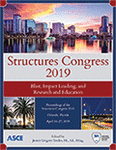Structures Congress 2019
Application of Absolute Nodal Coordinate Formulation for Dynamic Progressive Collapse Analysis
Publication: Structures Congress 2019: Blast, Impact Loading, and Research and Education
ABSTRACT
Progressive collapse, a chain reaction or disproportionate propagation of failures following damage to a relatively small portion of a structure, has drawn attention from researchers and the public because it may lead to severe loss of life and property. Progressive collapse data are difficult to observe in situ and expensive to produce at large scales in laboratory testing. Because of the large deformations involved in structural collapse, lateral constraints at the beam ends exert variable axial forces on beams, which then provide extra collapse resistance known as compressive arch action and catenary action. In this paper, the absolute nodal coordinate formulation (ANCF) is combined with the fiber element method to build a finite element beam formulation for nonlinear dynamic progressive collapse simulation of reinforced concrete Euler-Bernoulli beam-column elements. ANCF is a non-incremental nonlinear finite element formulation proposed to describe the large deformation of moving bodies in multibody systems. Compared with traditional formulations, ANCF uses position vector gradients to describe the rotation of the body and strain state, thereby keeping the mass matrix constant and avoiding the need for interpolating non-vectoral rotation parameters. The explicit central difference method is applied to calculate the dynamic response of collapsing structural systems, and an example is presented in this paper.
Get full access to this article
View all available purchase options and get full access to this chapter.
REFERENCES
Abbasnia, R., & Nav, F. M. (2016). “A theoretical method for calculating the compressive arch capacity of RC beams against progressive collapse.” Structural Concrete, 17(1), 21-31.
Bao, Y., Kunnath, S. K., El-Tawil, S., & Lew, H. S. (2008). Macromodel-based simulation of progressive collapse: RC frame structures. Journal of Structural Engineering, 134(7), 1079-1091.
Bathe, K. J., & Bolourchi, S. (1979). “Large displacement analysis of three-dimensional beam structures.” International Journal for Numerical Methods in Engineering, 14(7), 961-986.
Berzeri, M., & Shabana, A. A. (2000). “Development of simple models for the elastic forces in the absolute nodal co-ordinate formulation.” Journal of Sound and Vibration, 235(4), 539-565.
Christiansen, K. P. (1963). “The effect of membrane stresses on the ultimate strength of the interior panel in a reinforced concrete slab.” The Structural Engineer, 41(8), 261-265.
Department of Defense (DOD). (2010). Design of Buildings to Resist Progressive Collapse. Unified Facility Criteria, UFC 4-023-03, Washington, DC.
General Services Administration (GSA) (2003). Progressive Collapse Analysis and Design Guidelines for New Federal Office Buildings and Major Modernizations Projects. GSA Guidelines.
General Services Administration (GSA) (2013). Alternate Path Analysis and Design Guidelines for Progressive Collapse Resistance. GSA Guidelines.
Gerstmayr, J., & Irschik, H. (2008). “On the correct representation of bending and axial deformation in the absolute nodal coordinate formulation with an elastic line approach.” Journal of Sound and Vibration, 318(3), 461-487.
Goetz, A. (1970). Introduction to Differential Geometry. Addison Wesley Publishing Company.
Le, J. L., & Xue, B. (2014). Probabilistic analysis of reinforced concrete frame structures against progressive collapse. Engineering Structures, 76, 313-323.
Lew, H. S., Bao, Y., Sadek, F., Main, J. A., Pujol, S., & Sozen, M. A. (2011). “An experimental and computational study of reinforced concrete assemblies under a column removal scenario.” NIST Technical Note, 1720, 106.
McKenna, F., Scott, M. H., & Fenves, G. L. (2009). “Nonlinear finite-element analysis software architecture using object composition.” Journal of Computing in Civil Engineering, 24(1), 95-107.
Menegotto, M., and Pinto, P. E. (1973). “Method of analysis for cyclically loaded RC plane frames including changes in geometry and non-elastic behavior of elements under combined normal force and bending.” In Proc. of IABSE symposium on resistance and ultimate deformability of structures acted on by well defined repeated loads (pp. 15-22).
Milner, H. R. (1981). “Accurate finite element analysis of large displacements in skeletal frames.” Computers & Structures, 14(3-4), 205-210.
Park, R., & Gamble, W. L. (1980). Reinforced Concrete Slabs. John Wiley & Sons.
Ruth, P., Marchand, K. A., & Williamson, E. B. (2006). “Static equivalency in progressive collapse alternate path analysis: reducing conservatism while retaining structural integrity.” Journal of Performance of Constructed Facilities, 20(4), 349-364.
Shabana, A. A. (1996). “Finite element incremental approach and exact rigid body inertia.” Journal of mechanical design, 118(2), 171-178.
Shabana, A. A. (1997). “Definition of the slopes and the finite element absolute nodal coordinate formulation.” Multibody System Dynamics, 1(3), 339-348.
Shabana, A. A. (2012). Computational Continuum Mechanics. John Wiley & Sons.
Su, Y., Tian, Y., & Song, X. (2009). “Progressive collapse resistance of axially-restrained frame beams.” ACI Structural Journal, 106(5), 600.
Taucer, F., Spacone, E., & Filippou, F. C. (1991). A fiber beam-column element for seismic response analysis of reinforced concrete structures (Vol. 91, No. 17). Berkeley, California: Earthquake Engineering Research Center, College of Engineering, University of California.
Xiao, H., & Hedegaard, B. (2017). “Flexural, Compressive Arch, and Catenary Mechanisms in Pseudostatic Progressive Collapse Analysis.” Journal of Performance of Constructed Facilities, 32(1), 04017115.
Information & Authors
Information
Published In
Structures Congress 2019: Blast, Impact Loading, and Research and Education
Pages: 93 - 105
Editor: James Gregory Soules, McDermott International
ISBN (Online): 978-0-7844-8224-7
Copyright
© 2019 American Society of Civil Engineers.
History
Published online: Apr 22, 2019
Published in print: Apr 22, 2019
Authors
Metrics & Citations
Metrics
Citations
Download citation
If you have the appropriate software installed, you can download article citation data to the citation manager of your choice. Simply select your manager software from the list below and click Download.
